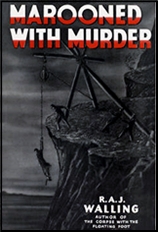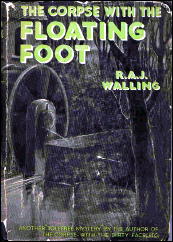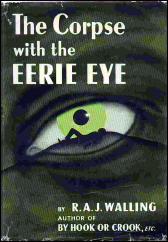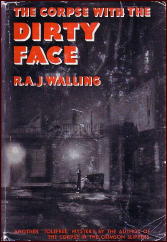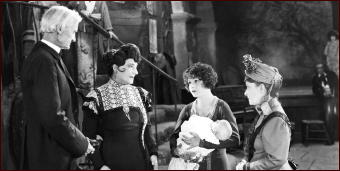HOME OF MYSTERY:
The Modern Romance Comedy Mystery
by Michael Shonk
In the world of fiction, there is a black door. The door stands alone. To its left is a beautiful garden lit in soft focus sunshine. To its right, ugly weeds force themselves up through broken concrete in the blackest of night. Open the door and you will find yourself in the Home of Mystery.

Designed from plans stolen from the Doctor in the Home of Science Fiction, it is larger inside than outside. The Home of Mystery is endless and defies all laws of science. Sub-genres merge and separate. Writers, characters, and books can exist in more than one place at the same time.
I head for the comedy mystery wing, a multi-floor structure. The classic era is on the bottom floor, but I take the stairs to the modern era one floor above.
I am in a hallway, cozies to my left, hardboiled to my right. I look to my left and pass doors for other sub-genres, “little old ladies,” “pets,”, and “special interests.” Finally, I see a lavender door covered by a cartoonist drawing of a thin perky young female in a short dress. I have found what I was looking for, the Modern Romance Comedy Mystery. I knock.
A pretty Heroine greets me. She stares at me suspiciously and tells me that Men’s Adventure Pulp is across the hall. I explain how much I enjoyed Hailey Lind’s (Julie Goodson-Lawes and Carolyn Lawes) “Art Lovers” series featuring former art forger Annie Kincaid, and I wanted to learn more about MRCM. Reluctantly, she let me in.
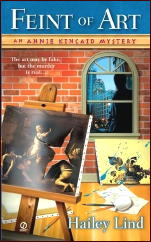
The room is full of more light and color than I am used to in the mysteries I normally read. The place is comedically disorganized and messy, yet clean.
My guide talks about her idol, Stephanie Plum. It is hard not to notice the influence Janet Evanovich’s series has had on MRCM. Plum is a feisty, funny, horny woman with a slow sex life and active sexual fantasy world. As many MRCM books that followed, the books feature a supporting cast of comic relief characters, and a popular romance subplot: the triangle. Stephanie loves good cop Joe Morelli but lusts for bad boy Ranger.
The Heroine mentions New York Times bestselling “Bibliophile” series by Kate Carlisle, but suddenly stops talking, distracted by some bad boy beefcake in skintight leather. After a few uncomfortable moments I walk on. She does not move, unaware I have left.
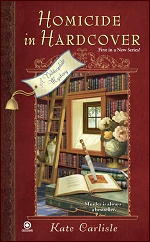
A man and a woman’s screams make me think about Maddie and Jack from the “High Heels” series by Gemma Halliday. The man is a cop and the woman is an amateur detective. Both scream at each other at the same moment, “Mind your own business!”
They are the screwball couple of MRCM, two strong willed people who “hate” each other to the point of falling in love. Predictably, the screaming couple are now in each other’s arms as they fade out of the room. In MRCM, most sex and violence happens off page.
My former guide has not moved. Bad boy beefcake notices her and smiles. Embarrassed, she runs off, bumping into another popular romantic subplot.
Happy Couple is trying to hide in the shadows, content just to be alone together. They remind me of award-winning Donna Andrews’ Meg Langslow and Michael. Happy Couple tell me they had met in her first book and their relationship has grown more serious as the series continued. Spotted, their supporting cast attacks them, odd parents, strange siblings, attention demanding pets, wacky friends, all separating the comically frustrated lovers.
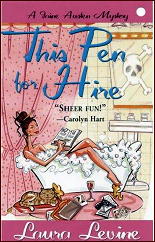
There are endless variations of the romance subplot, from unlucky in love (Jaine Austen by Count Chocula’s creator Laura Levine) to the strange (Kasey Michaels’ Maggie Kelly, mystery writer, who finds the man of her dreams when her fictional hero Saint Just comes to life).
I spot the MRCM femme fatale, the gorgeous blonde bitch who usually annoys the Heroine, but sometimes is the murder victim. Typical of MRCM, she just flirts, teases and then is gone.
I understand why the Heroine thinks more about sex than the mystery. Who cares who the killer is after all this “talk”? Even fictional characters can take only so much. To drive such thoughts from my mind, I think about what makes a Modern Romance Comedy Mystery.
The books are short quick reads, told in first person, the fourth wall is often ignored, the heroine’s life is threatened, and the victim often deserves to die. The characters’ lives are more important to the story than the mystery. The characters change and grow as the series progresses. It is wise to read an MRCM series in order.

The female amateur detective gets involved because of one of the following: she is the main suspect, she knows the main suspect, she feels responsible for the accused problems, the cops are idiots and/or order her to go away, the killer is after her, or she keeps falling over dead bodies.
Sales have moved many MRCM series from original paperbacks to hardcover releases, such as Nancy Martin‘s “Blackbird Sisters.”
Of course there is my reason for reading them: they are funny. From pun titles, such as Slay It with Flowers by Kate Collins, to some of the funniest comedy in fiction today, the MRCM are fun to read.
Still suffering from my encounter with the MRCM femme fatale, I think I’ll pick up one of the bimbos across the hall in Men’s Adventure Pulps.

